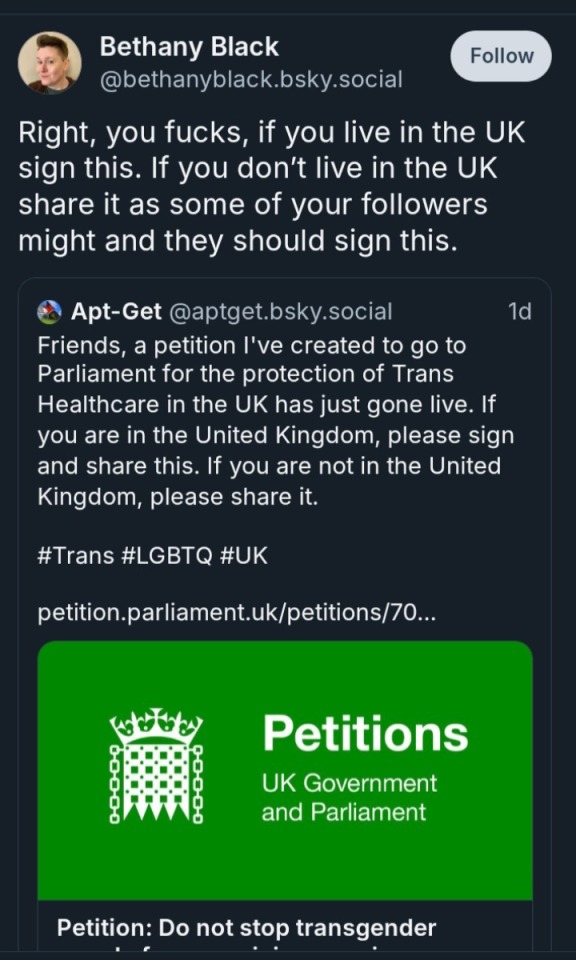Don't wanna be here? Send us removal request.
Note
You’ve noted your distaste for the alignment system before, and I was wondering what you thought about using Magic the Gathering color identity in place of it. I’ve started using that in my own game and it feels much better
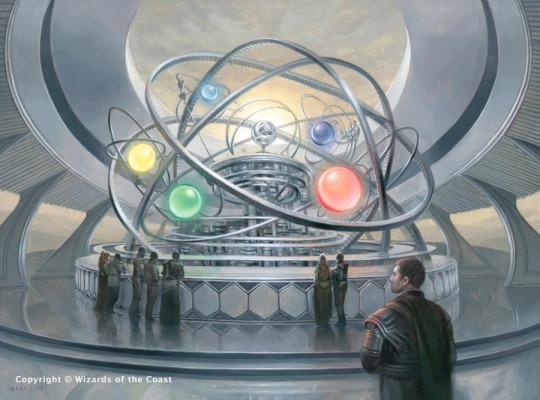
Inspiration Station: Magic the Gathering
TLDR: I really like the color alignment system as it can communicate a lot about a character's moral outlook and general vibe a lot clearer than regular alignment can. I like it so much infract that my drafts blog uses MTG color combinations as a sorting system so I can find things that go together easier. That said, its an extra level of game knowledge for new players to understand/have to do be taught. Alignment is supposed to give new players an idea how their character might act, and it's a lot easler for someone who's never roleplayed before to wrap their minds around acts that are "lawful" or "good" than for them to try to guide their character in a particularly "Blue" direction.
While I'm going to go on a bit of a ramble about this, I'm going to start with an explination of what "Color Identity" is for all the members of my audience that haven't lost years of their lives and chunks of their disposable income to a particular trading card game.
In Magic the Gathering (MtG from hereon out), there are five "elements" of magic that encompas the bredth of existance, all with their own emotional and thematic cores and endless interpretations of what they and their combinations represent.
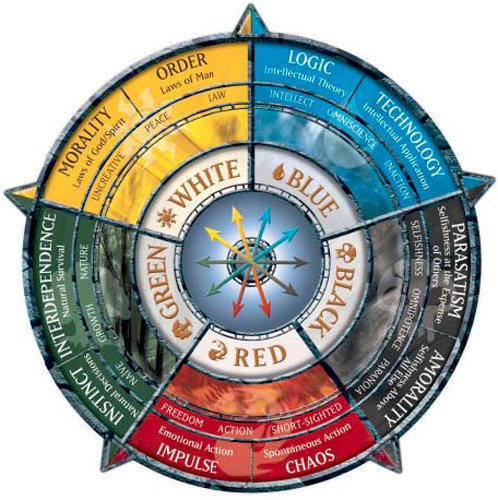
Anything from creatures to magic to places to civilizations can be found in some combination of these one to five colors, which in turn have relationships with eachother ( harmonizing with their neighbors while conflicting and complimenting with the ones across from them). This makes it a great shorthand from a design perspective, as it links together ideology, iconography, and gameplay into a palate that you can use to paint your characters and settings. There are quite a few "Using the color-pie in d&d" videos on youtube which I encourage you to check out, as they can do a much better job explaining the basics than I could do here.
Advice on how you can use this framework in your own games below the cut:
1: MTG colors as character alignment
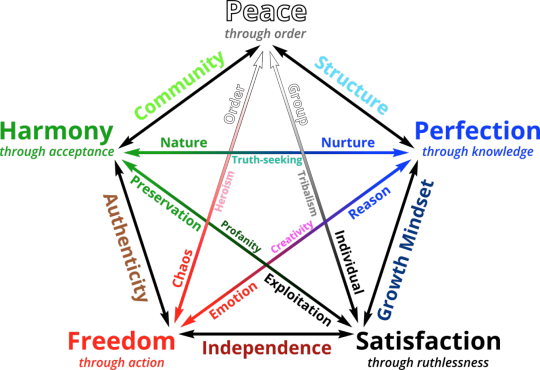
If you take a step back and consider the colors not as basic pokemon elements ( wood, water, fire, life, death) but as embodiments of different outlooks and philosophies, the color pie system suddenly becomes a radically efficient tool for summarizing how a character or culture carries out its beliefs, with the understanding that individuals within that culture will mix in new elements or lean away from others depending on their personal predilections. A character who relies on luck and wits (Blue-Red) may be tempted towards story beats that indulge either of their color synergies, but chafe against systems that would deny a part of themselves ( Such as the rule of a Black-White Authoritarian noble or the simplicity of Green-White peasant life).
2: MTG colors as writing tools
The fun in understanding how characters in your story fit into the color wheel isn't only in assigning them a static position, its in testing to see how they evolve and grow when exposed to external stimuli. Will the Blue/Black spymaster veer towards duty to their state (white) or personal power (red), will the righteous Red/White paladin give up their honor for vengeance ( becoming only red) or achieve some level of enlightenment ( white) after suffering through a crisis of faith.
Through the colorpie, and understanding your characters, you can make narrative arcs easy, or at least pencil some interesting questions as you develop the rest of the story.
3: MTG colors as setting design
The different colors have historically been tied to different types of terrain, and while I tend not to do a 1:1 conversion for all of my settings, its very easy to see how thematic throughlines can be made between setting and environment ( yes, necromancers probably would hang out in places full of shadows and rot, but those that embody Black's aspects of ambition and manipulation probably live in settlements infused with some form of social or infestructure decay, or perhaps a dark history concealed just beneath the surface)
To that end, I like to think of small to medium settlements as possessing a dual color identity made up partially of their land and culture, while larger settlements and nations tend to be two or three colors as they are a composite of diverse groups and interests. By looking at these combinations, finding contrasts between them and synergies with outside elements, you can easily begin to set up political and social dynamics: A White/Red/Green kingdom may have contrasting demographics between a warrior nobility ( WR), a traditionalist peasantry ( WG), and nomads who live on the frontier (RG). The kingdom could be threatened by an invading lich (UB) or by an alliance of nomads and peasants who resent the warrior nobility for their conquest generations ago (BRG)
4: MTG colors as game design
Bo yourself a favor and every time you're struggling to make a dungeon, try to figure out what color identity it has. Instantly you've given yourself a massive dose of inspiration for monsters, traps, hazards, and iconography for you to mine simply by visiting the gatherer and scrolling through the visual spoiler. Generally you can do this by thinking about where it was built and by who, with further richness added by thinking about what sort of creatures from the locality have crept in during the meantime and how their color identities harmonize and contrast with the dungeons own.
Likewise, if you're trying to think of abilities/gear to give a player or npc, think about how the different colors play:
White wants to bolster their allies before clashing head on
Blue wants to be tricky until they get in position to outplay their opponent
Black wants to fight dirty until they can really twist the knife
Red wants to go recklessly and blow their opponent away before they can retaliate
Green wants to level the playing field before getting really strong and stomping their foes into the floor
These playstyles ( and their combinations) can guide you in everything from what loot to give your party to the way monsters behave during an encounter: A (GR) barbarian would probably never want to pick up a (u) wizard's staff, but they might be tempted by a (UR) flaming arcane blade that let them expand their usual toolkit by going ethereal. A pack of hungry (BG) ghouls would lurk in the shadows of their crypt until they could ambush their prey, retreating to let their fetid bites weaken the party before sweeping back in with more numbers.
799 notes
·
View notes
Photo
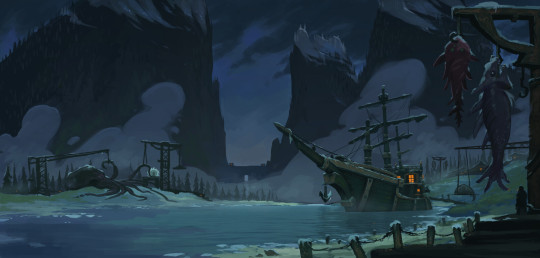
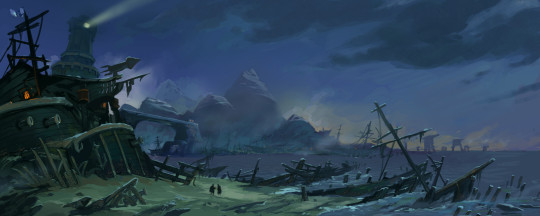
Setting: Varussha, Land of the Thwarted Fleet.
Background & Enviroment: The wreckage of empires litter the chilly beaches of Varussha, tossed up by the tide in the decade or so since the northern sea played host to the battles between three marauding armadas. Considered little more than a backwater tribute state by the great powers of the current age, Varussha has seen a steady wave of immigration as castaways, pirates, and refugees seek somewhere safe from the constant struggle of the maritime empires.
These emigres settle along the shores and waterways, using the flotsam of their former vessels to construct makeshift settlements and harbors, eeking out what existence they can as fisherfolk and traders as they slowly make their way inland. The upriver highlands of Varussha are mostly the grazing ground of woolly cattle, presided over by fortified villages and old clan chieftains, who all owe fealty to a king elected by the different clans. The current king, Edralf, has welcomed the newcomers and has taken personal interest in the resettlement process. Though his nation may be small, and his people may chafe at being forced to share it with a horde of outlanders, Edralf sees the potential in infusing the stagnant culture of his realm with new ideas, as well as opening his harbors to the profits their piracy provides.
Mood: Darkwater horror, stone circles and thunderstorms. A tenuous arrangement between a former viking culture and a currently unsettled pirate populace.
Adventure Hooks:
Our party starts their adventure in one of Varussha’s newly established freeports. Once little more than a trading village on a well traveled river, the town has exploded with newcomers and their rough and tumble ways. The party can escape the bustle of town by joining up on an “expeditionary” vessel, or help outsiders and villagefolk navigate the challenges of adapting to this new world together. Success in these matters may find them called upon by kin Edralf himself, who’s interested in having agents who can help him bring his particular vision of Varussha’s future to pass.
With a hold full of hard won ( ill gotten) goods, the party park their boat in a Varusshan harbor just as the last of the autumn storms turns to freezing chill. Wintering in a pirate cove may not be ideal, but it will give them plenty of time to count their spoils, get to know the crew, and stretch their-land legs after a few months at sea. Hopefully the icy waters and biting winds will cool the wrath of those the party as wronged before the thaw sees them on their next adventure.
One of the most ragged and ill-reputed settlements along the shore has turned full pirate, propping up a pirate known as “The Drowned Admiral” as their leader and freely engaging in raids among other settlements and attacks on any vessel they can find. Everyone wants the Admiral and her tossed back in the drink, most especially the crown, who know that such renegades can only cause division at home, and draw the attention of the great powers who put up with only so much of Varussha’s pirate harboring Antics.
Not all of Edralf’s people believe in his choices, or welcome his “new friends” to their ancestral land. Though the king is able to sway most of the holdouts with promises of piratical income, many of the staunchest and most traditionalist voices whisper of ousting Edralf and the newcomers, and electing a new king more dedicated to “The Old Ways”. Radical agents of these holdouts shout propaganda in the market square, paint graffiti with seditious call to arms in the street, and attack advocates for integration when they believe no one’s looking.
436 notes
·
View notes
Text
I don't think I can overstate the depth of impact trans women have had on indie ttrpgs.
408 notes
·
View notes
Text
Ian McKellen says that all gay people should be trans allies

Sir Ian McKellen urges gay people to be better allies to the transgender community.
The legendary actor and Stonewall co-founder joined It’s a Sin star Olly Alexander for a special LGBT+ History Month talk on TikTok on February 25, Pink News reports.
Sir Ian said:
“I do hear people ��� gay people – talk about transgender people in very much the same terms as people used to talk about your common or garden gay.
“The connection between us all is we come under the queer umbrella – we are queer. I quite like being queer actually.
“The problems that transgender people have with the law are not dissimilar from what used to be the case for us, so I think we should all be allies really.“
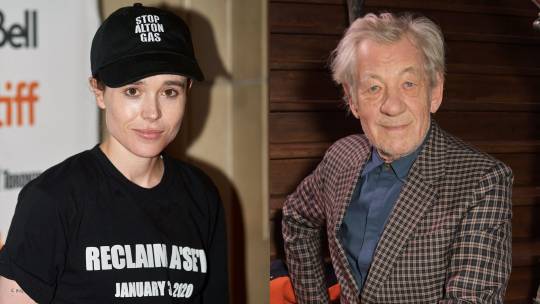
This is not the first time the actor has stood up to transphobes.
Speaking to lifestyle magazine Attitude, the veteran star talked about how happy he was about Elliot Page coming out as transgender.
He felt “so disappointed” with himself for not recognizing the struggles that the then-teenage actor could have been facing when they worked together.
The actor talked about why it is important to be honest with oneself.
Top photo from The Talks.
71K notes
·
View notes
Text
Mechanics point the camera at the subjects the game cares about.
Game mechanics are a way of telling the player what is important during the experience of the game. The inverse may not always be explicitly, but is often implicitly true. How far can this assumption be stretched is one of the many avenues of ttrpg game design that tortures my waking hours.
If there is not a mechanic for opening a door, the game does not care about litigating door opening. Doors may as well not exist as far as the game is concerned. In this way, the game mechanics themselves become the director of the camera. It refuses to even pay lip service to the possibility of a locked door. The same goes for inventory. If there are no rules for items on hand, the game may be assuming that all you always have what you need, when you need it. Or the opposite may be true. You never have what you need.
These grey areas become potential pain points when they come into conflict the depiction of the world that is being created by the game/player interaction. If the game cares not for doors, then all offices, castles, and bank vaults simply stand open. What do you do when the players ask to keep the sword that was dropped on the ground? This game has no rules for sword fighting.
From this line of thinking, you are also able to push on the mechanics that are included. If a game primarily includes mechanics for combat, the camera demands focus on violence and cares that violence is carried out in the game space.
If the game has mechanics for distinguishing races, it cares about the depiction of race. The game also cares about the depiction of racism and racial discrimination.
That last point likely feels like a jump for some. If we treat these inclusions with the same honesty that we treat all other game mechanics, the inclusion of race as a focus for the camera also brings along any facets that are included in the idea. If the game includes mechanics for locked doors, the world it imagines cares about the idea of security. If a game includes a mechanic for race, the world is conjures must feel some kind of way about it those races.
Beyond that, in a meta sense, the game may be asking you to make character decisions to create an optimal character. In these instances, the structure is creating an environment where you, the player, are engaging in discrimination of the races depicted in the game. This is a bit tangential an idea and may be a topic for another day.
——
This post ended up in a different point than I thought it would. I will come back to this idea and talk a bit more about my thoughts on how absence plays a role in game design.
145 notes
·
View notes
Text
My Template For Creating Dungeon Rooms...
About Your Dungeon Room…
Dungeon Room Name: What’s this Dungeon Room called? Instead of calling it “Room #3 on Floor 2″, try making each room unique by calling it something like “The Corridor of Knives” or “The Sinking Square”.
Naming your Dungeon Room peaks the interest of any DM reading it, as well as keeping the Name stuck in your head so you don’t have to flip through all those DM Notes mid-game…
Dungeon Room History: What’s the History of this Room? Is it the bedroom of a mad alchemist? Or is it the bathroom of a powerful necromancer?
Threat Level: This is how deadly this Dungeon Room is. Is it no threat at all, a simple setback, a moderate threat, or straight up deadly to anyone who enters?
Dungeon Motif: Is the Dungeon Underground, Abandoned, or does it lead to another Plane?
Selecting a Motif for the Dungeon Room based on the Dungeon can be pretty crucial. A mega-dungeon buried in the desert is very different from a ruined mega-dungeon that’s underwater…
Layout
Dungeon Walls: Are they stone or wood? Are they bare or decorated with elaborate tapestries and faded paintings?
Dungeon Floor: Is it stone, glass, wood, or something else? Will it make a noise if an oblivious Adventurer walks in?
Temperature: Is it unnaturally cold or unusually hot in this room? Maybe as the Party ventures deeper to the core of the earth everything gets supernaturally hot, or maybe as they venture deeper into a creatures lair, the air becomes supernaturally cold and the Adventurers can see their own breath!
Illumination: Is the room pitch black or lit by torches, or does the Room have small magical flames that burn forever?
Room Features: This is what’s in the Room. Statues, chests, pools of water, broken bottles. Room Features can be whatever the Adventurers see when they first enter the room, and what they could find if they explore the Room further.
Encounters
NPCs: This is usually a social encounter, such is meeting and talking to a friendly denizen of the dungeon, or maybe the ghost of a long-dead tomb-robber…
Traps: From corridors that flood with lava to false stairs that lead to a pit of boiling oil, these are the dangers a Dungeon Room (or corridor, or even stairs leading to the next Room or Dungeon Level) can have to stop any unwanted treasure-hunters.
Wandering Monsters: These are the Monsters that could possibly be found in this particular Dungeon Room, just in case the DM wants to spark some combat after a long session of busting down Dungeon Doors.
Puzzles: This is for the DM that likes to test their Players smarts. Maybe your Dungeon Room isn’t filled with Monsters, but instead a carefully composed riddle that only the Denizens of the Dungeon would know, and failure to solve such a puzzle could lead to a painful death at the hands of the Dungeon Room itself!
Hidden Treasure: It’s always good to put a little something in every Dungeon Room, most will be missed, but it’s always good to at least have something for the snooping Adventurers to find if they managed to survive whatever else they’ve just been through while going through this Dungeon.
601 notes
·
View notes
Text
fyi things like insulin, hearing aids, wheelchairs, glasses costing money at all is a form of structural ableism
259K notes
·
View notes
Text
Whoever fights monsters should see to it that in the process he does not become a monster, on account that a bunch of monsters can turn you into a monster by biting you. Vampires, werewolves, zombies. those are the big ones, there are others
27K notes
·
View notes
Text
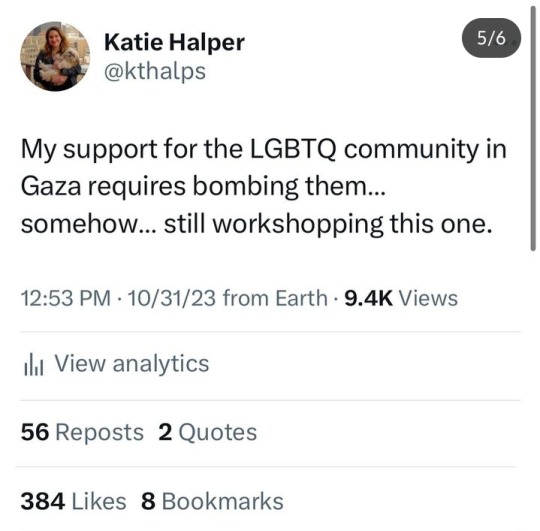

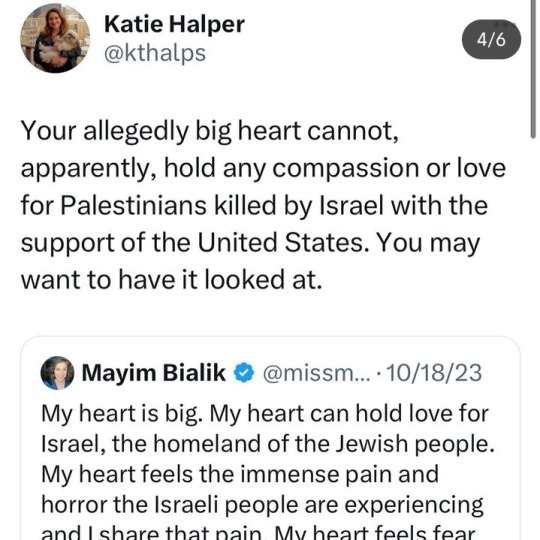
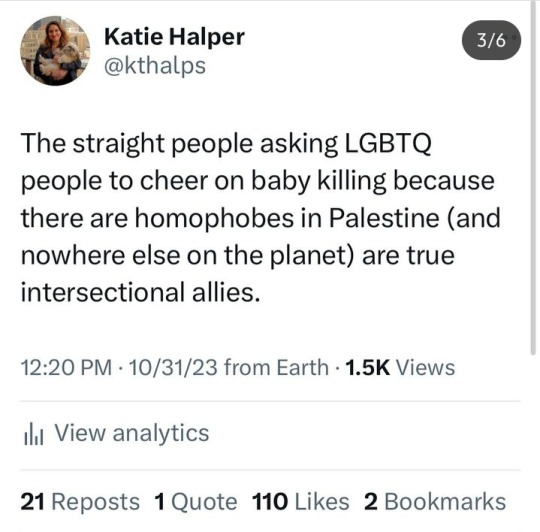
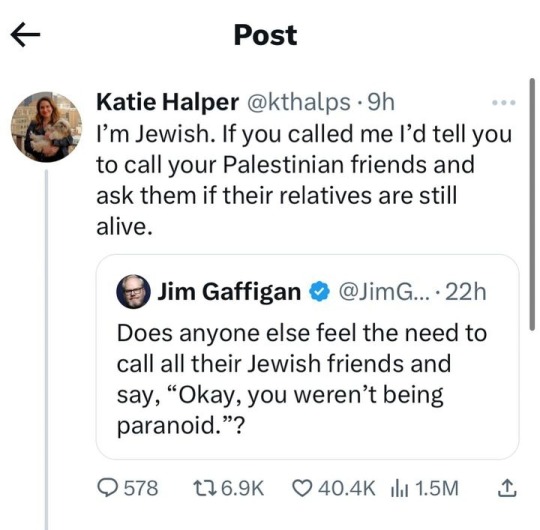

Important for people who are still stuck accusing people of antisemitism when they say genocide is actually not right.
39K notes
·
View notes
Text
i wish i could remember who made the recommendation to "make a list of all the different ways someone could feel about a topic in your fictional setting and then make each of them a character" because it is a great technique and is also extremely fun
18K notes
·
View notes
Text
actually, you know what, as a fan of transgressive art, tabletop rpgs as an artistic medium, and transgressive tabletop rpgs, I'm gonna say this up front: DrivethruRPG's willingness to host basically anything legal - no matter how graphic, tasteless or bizarre - is a good thing, and should be celebrated.
11K notes
·
View notes
Text
This paints such a beautiful picture
#queen of a peaceful little empire#why are you disturbing the sacred silence#been sleeping diagonally for three years#not giving up that territory#you’re not part of the itinerary#the simple joy of not having to share her fries#she’s thriving#she just booked a solo trip to Iceland
54K notes
·
View notes
Text
This is hitting my urban logistics button




As it was becoming clear the US was headed into trade war territory, I got really interested in farming and the logistics of keeping people fed. I turned that interest into "your cool city needs a food supply," available now!
it's a hack of "i'm sorry did you say street magic" and "Microscope," two gold-standard worldbuilding games. It was polished by Nico MacDougall, who gave me some great advice on how to make this game really align with the themes and ideas I had in the draft.
I've always been a sicko about logistics and agriculture (growing up in the US midwest will do that to you), and I hope this game helps people think about how great a privilege it is to eat.
2K notes
·
View notes
Text
"In order to save the world and all that is good, the morally gray main character *has to* kill the guy who turned into a knight templar after witnessing the morally gray mc's moral grayness ... What? No, there's no need for either of these characters to have a moment of introspection or for the story to explore self vs self themes"
See, **this** is why Aang's pacifism is revolutionary
8 notes
·
View notes
